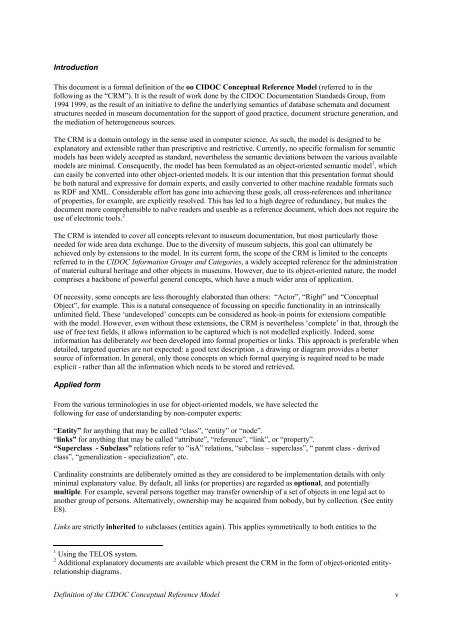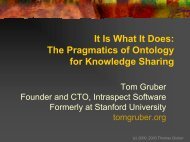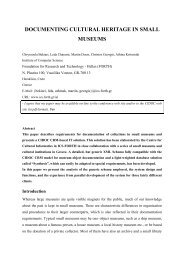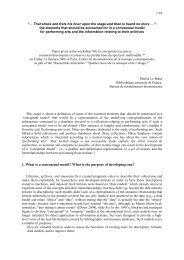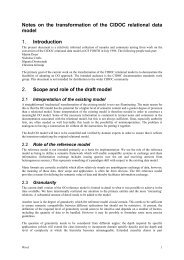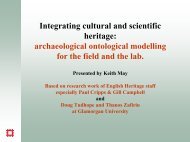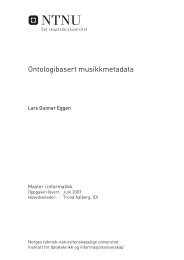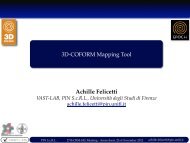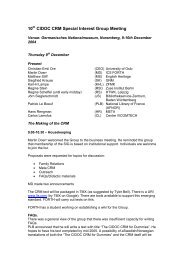pdf file - The CIDOC CRM
pdf file - The CIDOC CRM
pdf file - The CIDOC CRM
You also want an ePaper? Increase the reach of your titles
YUMPU automatically turns print PDFs into web optimized ePapers that Google loves.
IntroductionThis document is a formal definition of the oo <strong>CIDOC</strong> Conceptual Reference Model (referred to in thefollowing as the “<strong>CRM</strong>”). It is the result of work done by the <strong>CIDOC</strong> Documentation Standards Group, from1994 1999, as the result of an initiative to define the underlying semantics of database schemata and documentstructures needed in museum documentation for the support of good practice, document structure generation, andthe mediation of heterogeneous sources.<strong>The</strong> <strong>CRM</strong> is a domain ontology in the sense used in computer science. As such, the model is designed to beexplanatory and extensible rather than prescriptive and restrictive. Currently, no specific formalism for semanticmodels has been widely accepted as standard, nevertheless the semantic deviations between the various availablemodels are minimal. Consequently, the model has been formulated as an object-oriented semantic model 1 , whichcan easily be converted into other object-oriented models. It is our intention that this presentation format shouldbe both natural and expressive for domain experts, and easily converted to other machine readable formats suchas RDF and XML. Considerable effort has gone into achieving these goals, all cross-references and inheritanceof properties, for example, are explicitly resolved. This has led to a high degree of redundancy, but makes thedocument more comprehensible to naïve readers and useable as a reference document, which does not require theuse of electronic tools. 2<strong>The</strong> <strong>CRM</strong> is intended to cover all concepts relevant to museum documentation, but most particularly thoseneeded for wide area data exchange. Due to the diversity of museum subjects, this goal can ultimately beachieved only by extensions to the model. In its current form, the scope of the <strong>CRM</strong> is limited to the conceptsreferred to in the <strong>CIDOC</strong> Information Groups and Categories, a widely accepted reference for the administrationof material cultural heritage and other objects in museums. However, due to its object-oriented nature, the modelcomprises a backbone of powerful general concepts, which have a much wider area of application.Of necessity, some concepts are less thoroughly elaborated than others: “Actor”, “Right” and “ConceptualObject”, for example. This is a natural consequence of focussing on specific functionality in an intrinsicallyunlimited field. <strong>The</strong>se ‘undeveloped’ concepts can be considered as hook-in points for extensions compatiblewith the model. However, even without these extensions, the <strong>CRM</strong> is nevertheless ‘complete’ in that, through theuse of free text fields, it allows information to be captured which is not modelled explicitly. Indeed, someinformation has deliberately not been developed into formal properties or links. This approach is preferable whendetailed, targeted queries are not expected: a good text description , a drawing or diagram provides a bettersource of information. In general, only those concepts on which formal querying is required need to be madeexplicit - rather than all the information which needs to be stored and retrieved.Applied formFrom the various terminologies in use for object-oriented models, we have selected thefollowing for ease of understanding by non-computer experts:“Entity” for anything that may be called “class”, “entity” or “node”.“links” for anything that may be called “attribute”, “reference”, “link”, or “property”.“Superclass - Subclass” relations refer to “isA” relations, “subclass – superclass”, “ parent class - derivedclass”, “generalization - specialization”, etc.Cardinality constraints are deliberately omitted as they are considered to be implementation details with onlyminimal explanatory value. By default, all links (or properties) are regarded as optional, and potentiallymultiple. For example, several persons together may transfer ownership of a set of objects in one legal act toanother group of persons. Alternatively, ownership may be acquired from nobody, but by collection. (See entityE8).Links are strictly inherited to subclasses (entities again). This applies symmetrically to both entities to the1 Using the TELOS system.2 Additional explanatory documents are available which present the <strong>CRM</strong> in the form of object-oriented entityrelationshipdiagrams.Definition of the <strong>CIDOC</strong> Conceptual Reference Modelv


